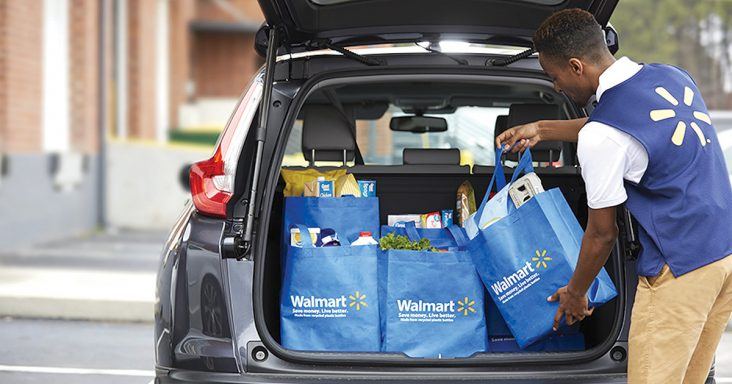Online grocery use holds steady at 69 million households
by February 16, 2022 2:59 pm 859 views

Walmart has hired nearly 50,000 personal shoppers for its grocery pickup service. It's "a huge milestone given the job didn't exist three years ago," said Tom Ward, senior vice president of central operations at Walmart U.S.
An estimated 69 million U.S. households made grocery purchases online in January, ringing up sales of $8.5 billion, according to a Brick Meets Click/Mercatus shopping survey. Overall sales were down 4% from December, and 8.9% lower than a year ago.
The drop in usage from December to January was not a surprise as more consumers likely opted to do shopping inside stores as the number of COVID-19 vaccinations continued to rise, according to analysts.
Brick Meets Clicks also found consumers were ordering at least some of their groceries online and the household penetration of online grocery use is expected to remain steady this year. Online grocery sales comprised about 12% of total grocery sales in January. The online share of grocery sales is not expected to rise as consumers are willing to spend more time in stores.
The report found online pickup orders rose 2.5% to $4 billion in January, while online orders via third-party delivery fell 6.3% to $3 billion. The ship-to-home sales accounted for about two-thirds of the overall online sales decline at $1.5 billion.
“These sales results show that circumstances connected to COVID continue to disrupt the way people shop, but in different ways than earlier in the pandemic,” according to David Bishop, a partner at Brick Meets Click.
He said increases in COVID case rates no longer have the same effect on buying patterns because of progress with vaccinations. He said the loss of financial assistance is another factor as the child care tax credits households received last year have ended. Bishop said some retailers also have had to alter store operations in January to address labor shortages associated with COVID-related absences in a tight labor market.
The survey found the weighted order average across online grocery held steady in January. For households using third-party delivery the average order rose 2% in January from a year ago. But the average order value for pickup at stores was 3% lower and those orders shipped to homes were 11% lower on average than a year ago.
The data also found by share, pickup represented 47% of online grocery sales in January, up 5% from a year ago. Delivery’s share rose to 35% in January, up fractionally from a year ago. The share of ship-to-home fell more than 5% to 18% in January, which was the lowest since before 2019, according to the survey.
Brick Meets Clicks said those who are using online grocery more often continue to rise with the average monthly usage up 6% from a year ago for those who pickup the online order at the store. The average monthly use for delivery orders was 2% from a year ago and those using ships to home fell 8% from January last year.
The survey found households placed an average of 2.7 orders in January, which was 33% higher than in the pre-pandemic period. The majority of the increase came in the click and collect and delivery methods, while average orders for ship to home were down 10% from a year ago.
Consumers also shopped at fewer stores in January than a year ago. Supermarkets took 26% of the online grocery shopping share in January, down 2% from a year ago. The mass channel, such as Walmart and Target, held a 7-point edge over supermarkets with a 58% market share in January.
“Grocers have a clear opportunity to drive stronger repeat purchase behavior,” said Sylvain Perrier, president and CEO of Toronto-based Mercatus. “In addition to providing a great customer experience, they also need to understand which loyalty drivers are unique to their customers and brand. When it comes to online grocery shopping, consider adding perks that cater to behavioral and emotional triggers, like offering a wider range of preferred pickup times or more frequent pickup time slots.”
The survey was conducted Jan. 29-30 and looked at the prior 30 days of grocery shopping data for U.S. households.
